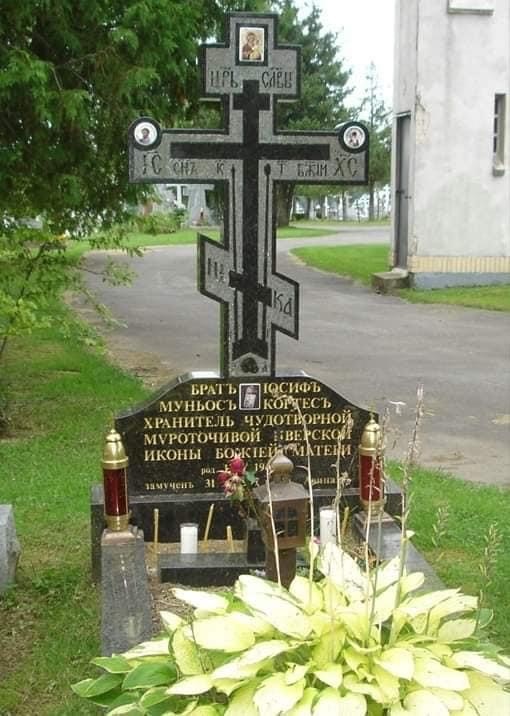
On the night of October 30-31 – 26 years ago, the servant of God Joseph (Muñoz-Cortes) was killed, in monastic vows – Ambrose, 05/13/1948 – 10/31/1997, the chosen one of the Mother of God and the keeper of Her myrrh-streaming icon “Iveron-Montreal”.
Born into a Catholic family in Chile. As a child, he showed a penchant for painting. Both he and his family wanted him to become an artist.
In 1962, at the age of 12, Jose, on the way to a Catholic church, accidentally heard wonderful singing coming from the open doors of the Holy Trinity Orthodox Church in Santiago.
The beauty of the temple decoration, icons and worship made a huge impression on the boy, and from then on he began to visit this church. Two years later he converted to Orthodoxy.
After studying at an Orthodox college, he went to Canada to the city of Montreal at the metochion of the monastic brotherhood of St. Job of Pochaev.
In 1982, during a pilgrimage to Holy Mount Athos, Joseph visited the Nativity of the Savior monastery. Here, in the icon-painting workshop, he saw the image of the Iveron Icon of the Mother of God that deeply struck him.
He persistently asked to sell him this icon, but was refused. The young pilgrim fervently prayed to the Mother of God to allow him to take Her image to Canada.
Already leaving the gates of the monastery, he saw the abbot hastening to him, who handed him an icon with the words: “The Blessed Virgin must leave with you.”
While on board a ship heading to the Athos port of Daphne, he heard an inner voice commanding him to go to the Iveron Monastery and attach his icon to the miraculous image of the Mother of God “Vratarnica,” the heavenly Guardian and Patroness of Athos. The icon given to him was copied from this image.
![]()
He fulfilled this command. Returning to Montreal, Joseph placed the “Vratarnica” icon in his room and read an akathist in front of it every night.
The donated icon began to flow abundantly with myrrh and fragrance from November 24, 1982, after returning to Canada. According to the memoirs of the murdered Joseph:
“On November 24 at three o’clock in the morning I woke up from a strong fragrance. At first I thought that it came from the relics or a spilled bottle of perfume, but when I approached the icon, I was amazed: it was all covered with fragrant myrrh! I froze in place from such a miracle!
Soon the myrrh-streaming icon was taken to the temple. Since then, the icon of the Mother of God has constantly streamed myrrh, with the exception of Holy Weeks.
It is remarkable that the myrrh flowed mainly from the hands of Christ and the Mother of God, as well as the star located on the right shoulder of the Most Pure One. At the same time, the back side of the icon is always dry.”
News of the miraculous phenomenon quickly spread, and the icon was placed in the Orthodox Cathedral in Montreal, where it was visited by a huge number of people.
Invitations and requests to Joseph came not only from different cities and countries, but also from other continents. He visited South America, Europe, and Australia. He visited with the icon not only churches and monasteries, but also nursing homes, boarding schools, hospitals, private houses and apartments, and other places where people called him to their place.
Through the icon, by the grace of God, many miraculous healings took place, but Joseph more than once said that the greatest miracle of the myrrh-streaming icon was that it moved people to repentance.
According to eyewitnesses, myrrh had a strong aroma of roses and was collected in vessels. Joseph was the custodian of this shrine for 15 years and visited Orthodox parishes in many countries with the icon.
Joseph, who accompanied the holy icon everywhere, always behaved very modestly, never attracted attention to himself, and during church services he stood quietly behind, unnoticed like a monk.
The miracle, which he was destined to be the first to witness, deepened his already strong spirit of prayer. He had 58 godchildren. And he prayed for each of them daily – and not only for them. His memorial was like a monastic synodikon.
Joseph did not have much money. Having found the icon, he made a vow that it would not become a source of his enrichment. And he carried it out until his death.
The keeper of the miraculous icon himself, according to the recollections of those who saw him, behaved very modestly and did not attract attention to himself during services. He developed diabetes mellitus from long journeys, but he hid his illness.
It is reliably known that at times he did not have enough money to buy medicines and basic necessities. Often he gave his last money to those in need.
Joseph always felt a special connection with Russia and spoke about this more than once in his interviews. And once in one of the conversations he directly called himself Russian. In his house were kept particles of the relics of Grand Duchess Elizabeth Feodorovna and nun Varvara, whom he especially revered.
He often returned to Athos. On Mount Athos in the early 90s he was tonsured a monk by Schema-Abbot Clement /+1997/ with the name Ambrose, in honor of the Venerable Ambrose of Optina. It was a secret tonsure that only a few people knew about.
In his last interview, published in the Russian Shepherd magazine published in San Francisco, as if anticipating his martyrdom, Joseph said:
“Believers must be ready to die for the truth, and not forget that by acquiring enemies here, we acquire the Kingdom of Heaven…
He who is faithful in small things will be faithful in great things when necessary. Given the opportunity to become confessors, we should not miss it. Having lost earthly life, we gain heavenly life. We must not fear death for Christ.”
In the summer of 1996, Joseph went to Athos to say goodbye to Schema-Abbot Clement, his spiritual father, who was departing to God. (Sche-abbot Clement died at the age of 103 on the Feast of the Triumph of Orthodoxy). Then the schema-monk told him that the next year – 1997 – would be fateful for him, and terrible events would occur.
On the eve of his martyrdom, Joseph visited the monastery of St. Nicholas on the Greek island of Andros to venerate its shrines.
The monk, who opened the doors of the main temple of the monastery for them, was extremely surprised that the ancient wall image of the Mother of God was tearing up.
The abbot of the monastery explained that the icon cries when terrible events are brewing, or during such events.
This sign of the Mother of God made a deep impression on Joseph, and he repeatedly said: “I feel that something terrible will happen very soon. I don’t know what exactly, but something will happen.”
He came to Athens on a false call, allegedly from a confessor who lived on Athos and on the night of October 31, 1997, Joseph Muñoz was killed in a room at the Grand Hotel in Athens, and the myrrh-streaming icon disappeared without a trace.
In 1998, a medical expert testified at the trial that it appeared that Joseph did not resist. He was carefully tied across the bed, there were signs of strong blows on his head and face, hemorrhage occurred in the brain, blood flowed from his eyes, his cheeks were cut, his Adam’s apple was crushed, signs of torture were visible on his legs, arms, and chest. Unknown people tied him up, and in such a way as to cause him the greatest suffering.
The judge showed terrible police photographs showing that Joseph died alone for a long time and painfully…
During the court hearing, it was noted that the murder was carefully planned; they were killed by professionals who wanted to “obtain information from their victim.” The ROCOR suggests that they tried to get from Joseph where the icon was.
The Greek press of that time wrote that the keeper of the Montreal icon was killed by Satanists. In the late 90s and early 2000s, several such groups operated in the country.
Many articles concluded that “the enemies of the faith could not see how he presented a miracle to the whole world, glorifying Christ and the Mother of God.” The media also drew analogies with the murder of three monks of Optina Hermitage by a Satanist on Easter 1993 in Russia.
The keeper of the myrrh-streaming icon of the Mother of God “Vratarnica” was buried 13 days after his murder in Athens. They wanted to perform his funeral service with a closed coffin and in a sealed plastic bag. But God judged differently. The coffin was open, the bag was torn, and everyone saw signs of torture. There were no signs of smoldering or smell.
According to his will, he was buried in the Russian cemetery at the Holy Trinity Monastery in Jordanville, New York (USA) on November 12, 1997.
Archbishop Laurus did not give his blessing to pour the foundation under which the coffin with the body of the martyr was buried: “It will be easier to open.”
According to eyewitnesses, on December 9, 1997, on the fortieth day, “the candles, which could not be lit due to strong winds, miraculously ignited spontaneously and continued to burn in the snow all day until they burned out completely.”
After the death of Joseph Muñoz, the myrrh-streaming Montreal icon disappeared. The Guardian always hid the shrine when he went somewhere without it.
“The fate of the Montreal Icon is unknown. The icon was not with brother Joseph in Greece, but no one knows where or with whom the icon was left. There are different theories about the further history of the icon, but there is no evidence that could confirm one or the other version. This means the fate of the icon remains a mystery.”
Previously, blogs suggested that the icon could have been quietly returned back to Athos, to the very monastery where the image was painted and where Joseph once saw it for the first time. Be that as it may, believers are convinced that the keeper of the miraculous icon not only kept it, but also preserved it.
In the Eastern American Diocese of the ROCOR, a commission has now been created to collect evidence for the canonization of Joseph Muñoz. The collected documents will then be sent to the Synodal Commission.






